If you’re interested in finding out the average neck size for men and women—and learning how these neck measurements affect your health—then you’re in the right place.
Using multiple scientific studies and anthropometric data from peer-reviewed journals, we set out to discover what a normal neck circumference is for both males and females.
After seeing our men’s neck chart and women’s neck size chart, you’ll also learn where and how to measure your neck circumference so that you can get an accurate measurement and assess your current health status.
Related Measurement Guides:
- Average wrist size
- Average male bicep circumference
- Average forearm circumference
- Average hip measurement
- Average leg circumference
- Average waist measurement
- Average calf circumference
- Average men’s chest size
- Average shoulder width
What is the average male neck size?

What is the average male neck size? Based on our examination of data from multiple studies and taking measurements of our own, the average men’s neck size is between 14 inches and 18 inches.
A male neck circumference measurement below 14 inches is considered small, whereas a measurement over 16 inches is typically considered medium or large, so a healthy neck size lies somewhere between these two values.
Average neck sizes also differ based on the population examined. For example, research shows that those with a high BMI have a significantly larger neck circumference than those of a healthy weight. [1]
Common Neck Sizes:
- 11 inch neck
- 12 inch neck
- 13 inch neck
- 14 inch neck
- 15 inch neck
- 16 inch neck
- 17 inch neck
- 18 inch neck
- 19 inch neck
- 20 inch neck
- 21 inch neck
- 22 inch neck
What is the average neck size for a woman?

What is the average neck size for a woman? Based on the data, the average female neck size is 13 inches for a woman of a healthy body weight.
More broadly speaking, the average female neck circumference is between 12 inches and 14 inches when you factor in women of more varied body masses.
In every study that we examined, the average man’s neck size was around 1.5 to 2 inches larger than the average woman’s neck size. [2]
This indicates that men typically have higher body masses and waist circumferences than women seeing as both of these measurements are associated with a larger neck size.
What is the average neck circumference for children and teenagers?
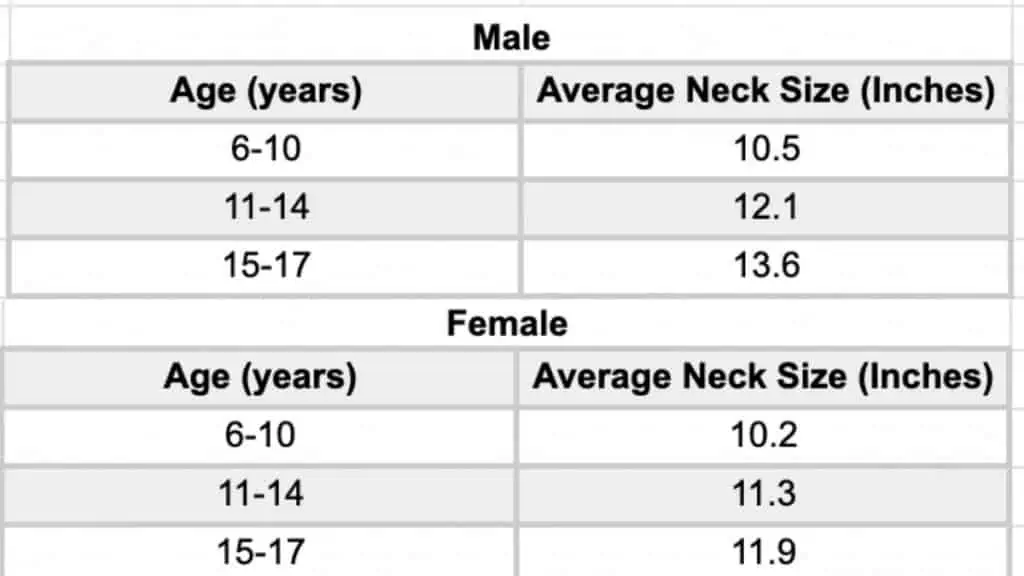
The average neck circumference for children and teenagers depends mostly on the age of the person and, to a slightly lesser extent, their gender.
The following data is based on a landmark Canadian Health Measures Survey that sought to create a reference dataset of neck sizes in children. [3]
The researchers measured the neck circumference of both healthy weight and overweight/obese children, which shows how body mass affects the neck size of children and teenagers.
The values below are based on the data collected for children of a healthy weight.
For children aged 6-10, the normal neck circumference is around 10.5 inches for boys and 10.2 inches for girls.
For children aged 11-14, a normal neck size was found to be 12.1 inches for boys and 11.3 inches for girls.
For teenagers aged 15-17, the standard neck size was 13.6 inches for boys and 11.9 inches for girls.
Men’s neck size chart
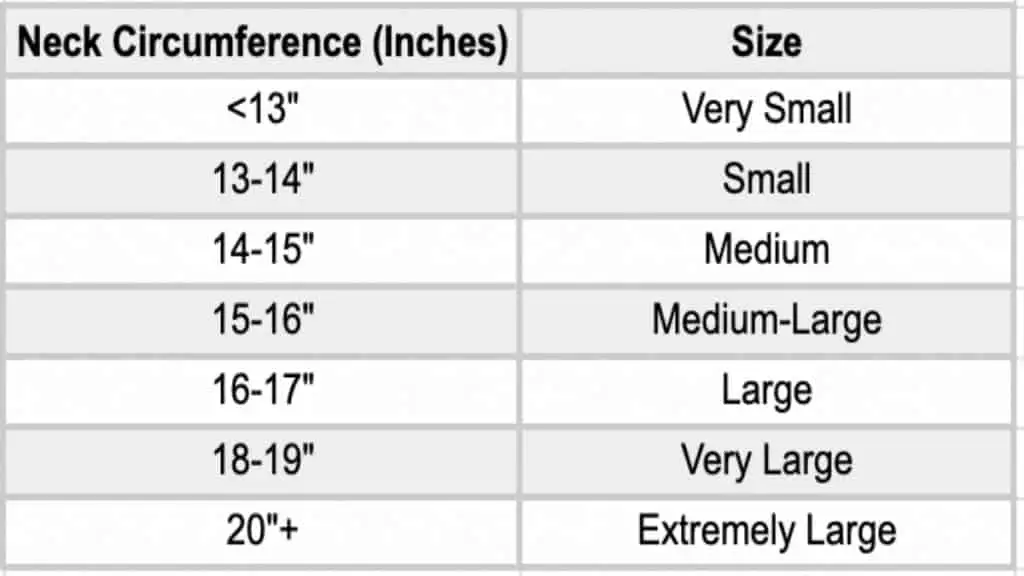
The following male neck size chart is based on our extensive examination of anthropometric data collected both in-house and from scientific studies.
With this in mind, the above numbers are not intended to represent specific clothing sizes (although they may well do for certain clothing brands).
Rather, the categorizations of “small”, “medium”, “large” etc., are based on how big your neck actually is in relation to the average neck measurement.
For this reason, we included both a male and a female neck measurement chart—males simply have thicker necks than females on average.
Female neck size chart
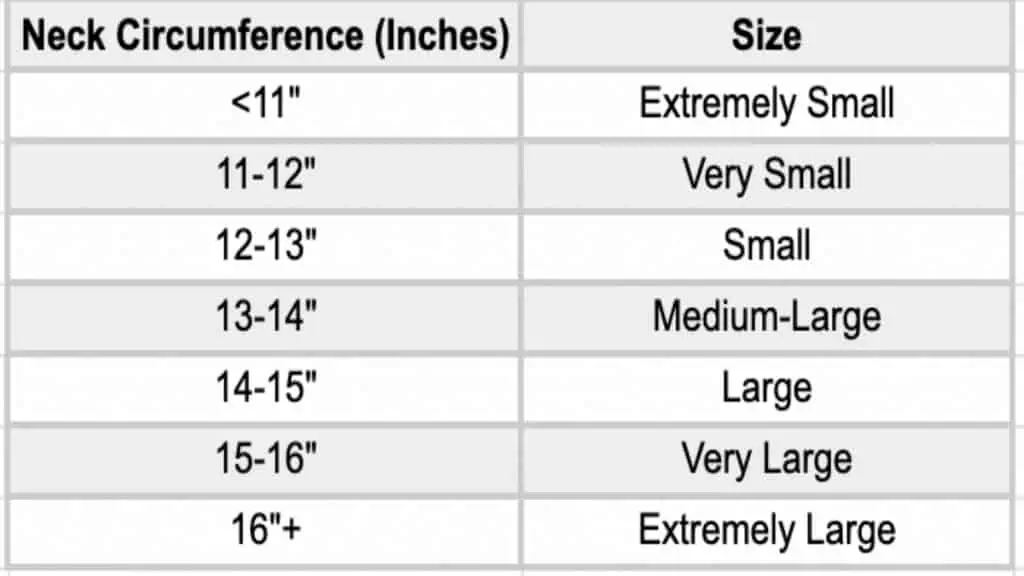
The following female neck circumference chart will help you to gauge how big your neck is in relation to that of the average woman.
If your neck circumference measurement falls into one of the larger categories, then it’s likely that you also have a higher than average waist size and BMI, seeing as these two values are correlated with your neckline measurement.
How to measure your neck size correctly

This step-by-step guide will show you how to determine your neck size so that you can get an accurate measurement and select clothes that fit you well.
You may also want to measure and track your neck size so that you can track your weight loss progress—if your neck circumference is shrinking, then it’s likely that your other circumference measurements are as well.
- Stand up, ideally in front of a mirror, and look straight ahead. Avoid tilting your chin up or down.
- Wrap a flexible tape measure around the widest part of your neck (usually close to the base of the neck, just below the Adam’s apple for men).
- Ensure that you’re not pulling the tape measure too tightly. The tape shouldn’t be slack, but you shouldn’t artificially reduce your measurement by pulling the tape too tightly.
- Observe where the two ends of the tape measure cross—this is your neck size.
- Take one or two more measurements so that you can verify your neck circumference and ensure the utmost accuracy.
What is considered a large neck circumference?
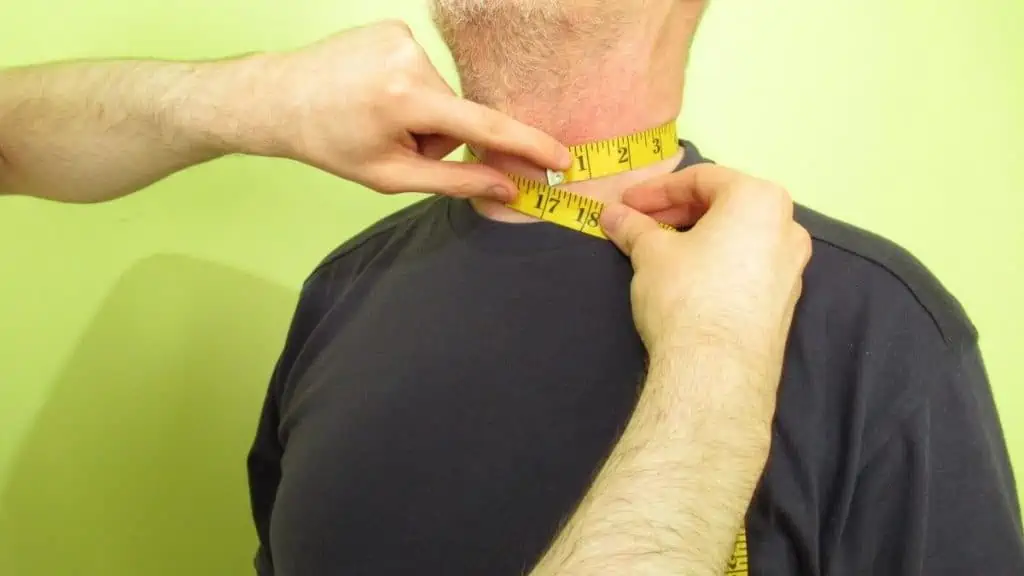
Now that you know the average neck sizes for men and women, it’s time to learn what measurement is typically considered a large neck size for males and females.
For a man, a large neck circumference is generally considered anything over 16 inches or, in some cases, 17 inches. Indeed, research shows that the average neck circumference for males with sleep apnea is 16.25 inches. [4]
For a woman, a large neck size is typically considered 14 inches or more. This value is taken from the above-cited neck circumference study and also corroborates with our own data and observations.
If you have a large neck due to having a muscular neck, then it’s unclear how much this affects your risk of developing sleep apnea.
Unless your neck is huge—and if it’s not accompanied by a high BMI—then it seems unlikely that having, say, a 16 inch neck will do you any harm.
Neck circumference FAQ
Learn everything there is to know about neck measurements in this helpful FAQ.
What is the average neck size by height?

Unfortunately, there is currently no published data that examines the average neck size by height.
However, we know that a higher body mass is associated with a thicker neck circumference measurement, and we also know that taller people tend to weigh more than shorter people.
So, based on this set of facts, the taller you are, the larger your neck should naturally be.
On the other hand, if you’re tall and slim, then your body mass is going to be distributed over a much larger area, meaning that your neck measurement might actually be on the small side.
Additionally, there is little difference in the muscularity of most people’s necks since it’s not a body part that most people train with any kind of resistance.
Therefore, body weight, regardless of height (though weight does generally increase with height), has the biggest influence on neck size.
What is the average neck circumference by age?

The average neck circumference tends to increase up until middle age and then slowly decrease as one gets older and loses muscle mass due to sarcopenia.
For example, in one North American study, teenage boys had an average neck size of 13.6 inches, which is slightly below the 14-16 inch average for healthy adult men.
Other research shows that a declining neck girth is a marker of frailty in middle-aged and elderly women (it’s highly likely that the same would hold true for men). [5]
So while there is no specific research that examines neck girth at particular ages, it’s clear that your neck size typically peaks between the age of 30-55 and then decreases as you age.
Where should you measure your neck for body fat testing?

If you want to measure your neck size in order to gauge your body fat level, then make sure to measure around the thickest part of your neck. This is usually close to the base of the neck and just below the Adam’s apple in men.
On the other hand, if you want to take a caliper measurement rather than a neck circumference measurement, then you’ll want to take a skinfold measurement somewhere between your chin and neck, likely where there’s the most skin/body fat.
How to measure your neck size without a measuring tape

If you’re measuring your neck size in order to buy clothes (at least clothes that fit you well), then it’s important to use a flexible tape measure so that you can get an accurate reading.
If you don’t have this kind of tape measure, you can easily buy one for a few bucks. Alternatively, you can very likely have your measurements taken in some clothing stores, particularly those selling shirts.
However, if you want to measure your neck size without a tape measure, then your best bet is to use a piece of string or some other flexible material that you can comfortably wrap around your neck.
Essentially, you wrap the string around your neck as if it were a tape measure. Then, with a pen, you mark where the two ends meet and then measure between these two points.
How to measure your neck height and length
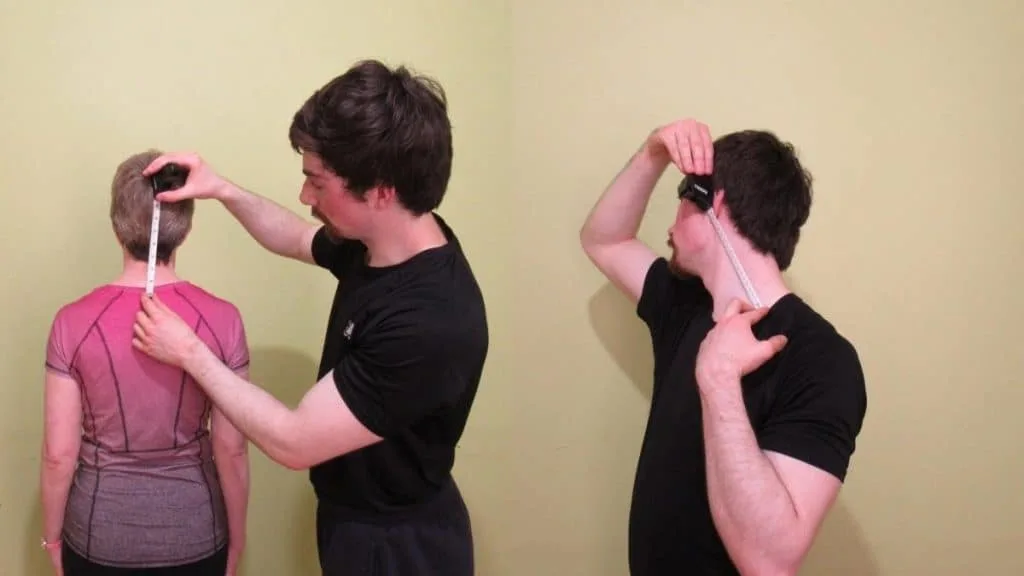
If you want to measure your neck height and neck length, you’ll need a tape measure and a mirror. If you don’t have access to a mirror, then you’ll need to get someone else to take the measurement for you.
Put one end of the tape measure just above your collarbone and place the other end just under your jaw. Just note that if you measure the side of your neck, you’ll likely get a longer measurement than if you measure from the front.
You can also take a neck length measurement from the back by measuring from just above the back of your shoulders to the bottom of your head (where the trapezius muscle stops and the bone of your head starts).
When taken from the back, neck height is another way of saying cervical spine length, which is a collection of bones on the back of your neck. [6]
Conclusion: Should you aim to have an average neck circumference?

Since a large neck circumference is associated with a high BMI and waist size—both of which can negatively affect your health—it makes sense to aim for a measurement on the lower end of the average neck size.
For men, this theoretically ideal neck size is somewhere between 14 and 16 inches, and for women, this value is between 12 and 13.5 inches.
Of course, if more of your neck size is due to muscle mass than fat tissue, then this is likely better for your health, seeing as muscle mass is a predictor of longevity, especially in older adults.
References
- Wang, X., Zhang, N., Yu, C., & Ji, Z. (2015). Evaluation of neck circumference as a predictor of central obesity and insulin resistance in Chinese adults. International journal of clinical and experimental medicine, 8(10), 19107–19113.
- Huang, B. X., Zhu, M. F., Wu, T., Zhou, J. Y., Liu, Y., Chen, X. L., Zhou, R. F., Wang, L. J., Chen, Y. M., & Zhu, H. L. (2015). Neck Circumference, along with Other Anthropometric Indices, Has an Independent and Additional Contribution in Predicting Fatty Liver Disease. PLOS ONE, 10(2), e0118071. https://doi.org/10.1371/journal.pone.0118071
- Katz, S. L., Vaccani, J. P., Clarke, J., Hoey, L., Colley, R. C., & Barrowman, N. J. (2014). Creation of a reference dataset of neck sizes in children: standardizing a potential new tool for prediction of obesity-associated diseases? BMC Pediatrics, 14(1). https://doi.org/10.1186/1471-2431-14-159
- Ahbab, S., Ataoğlu, H. E., Tuna, M., Karasulu, L., Cetin, F., Temiz, L. U., & Yenigün, M. (2013). Neck circumference, metabolic syndrome and obstructive sleep apnea syndrome; evaluation of possible linkage. Medical science monitor : international medical journal of experimental and clinical research, 19, 111–117. https://doi.org/10.12659/MSM.883776
- Tanaka, S., Ando, K., Kobayashi, K., Seki, T., Hamada, T., Machino, M., Ota, K., Morozumi, M., Kanbara, S., Ito, S., Ishiguro, N., Hasegawa, Y., & Imagama, S. (2019). Declining neck circumference is an anthropometric marker related to frailty in middle-aged and elderly women. Modern Rheumatology, 30(3), 598–603. https://doi.org/10.1080/14397595.2019.1627023
- Cleveland Clinic. (2022). Cervical Spine (Neck): What It Is, Anatomy & Disorders. https://my.clevelandclinic.org/health/articles/22278-cervical-spine

